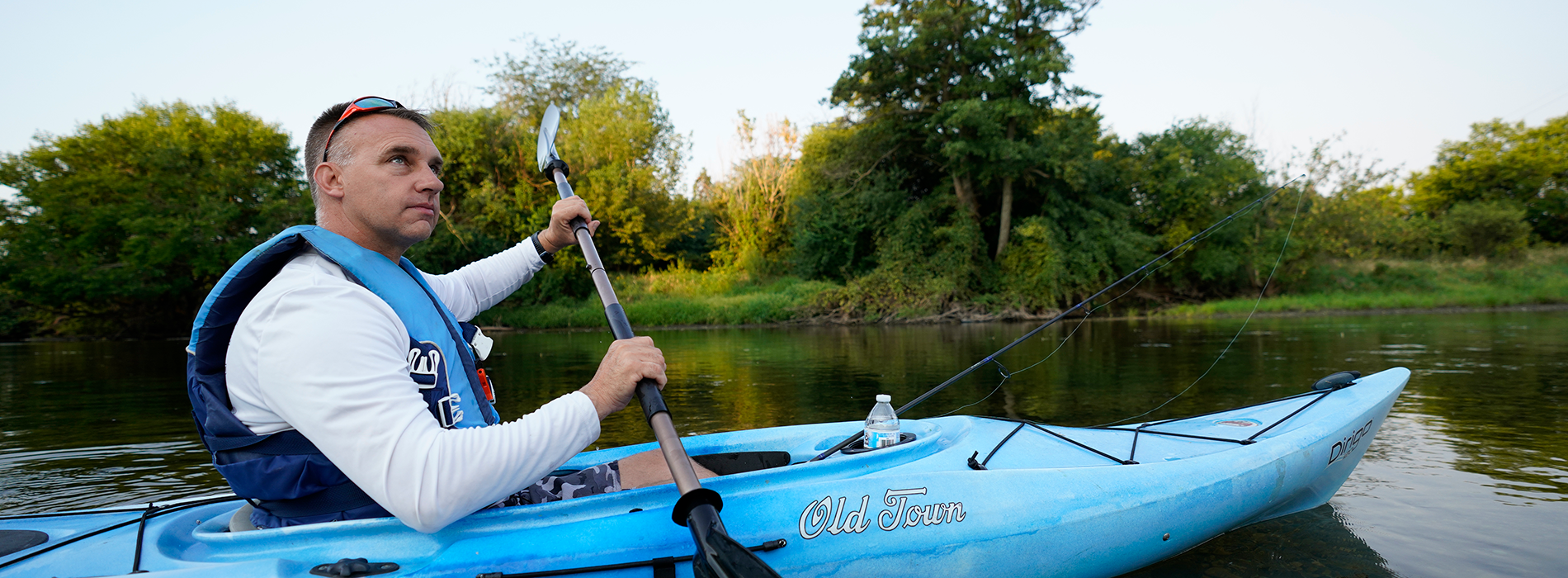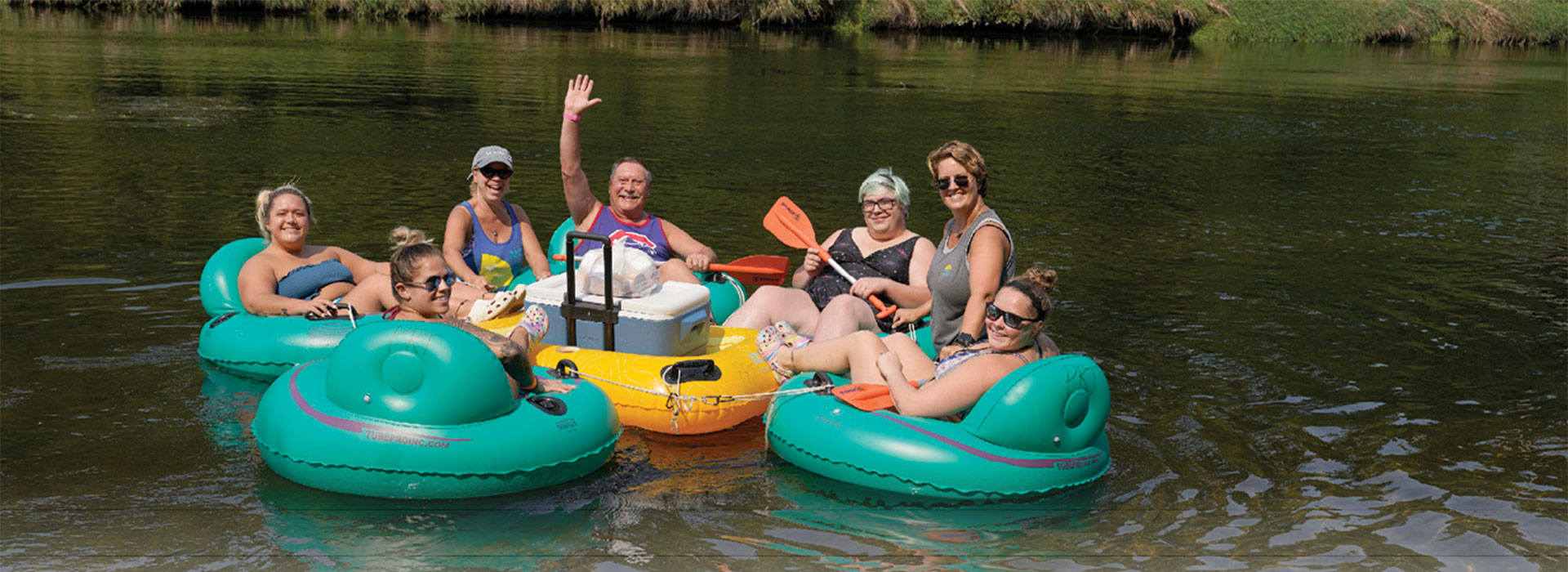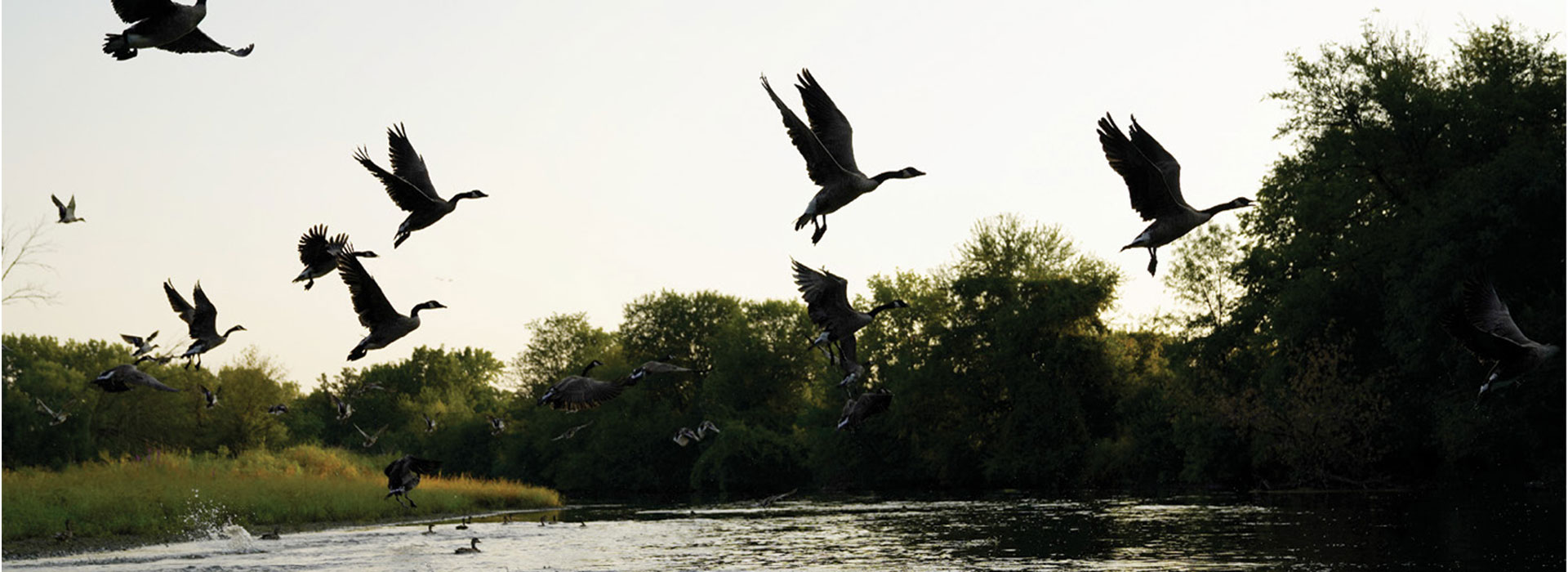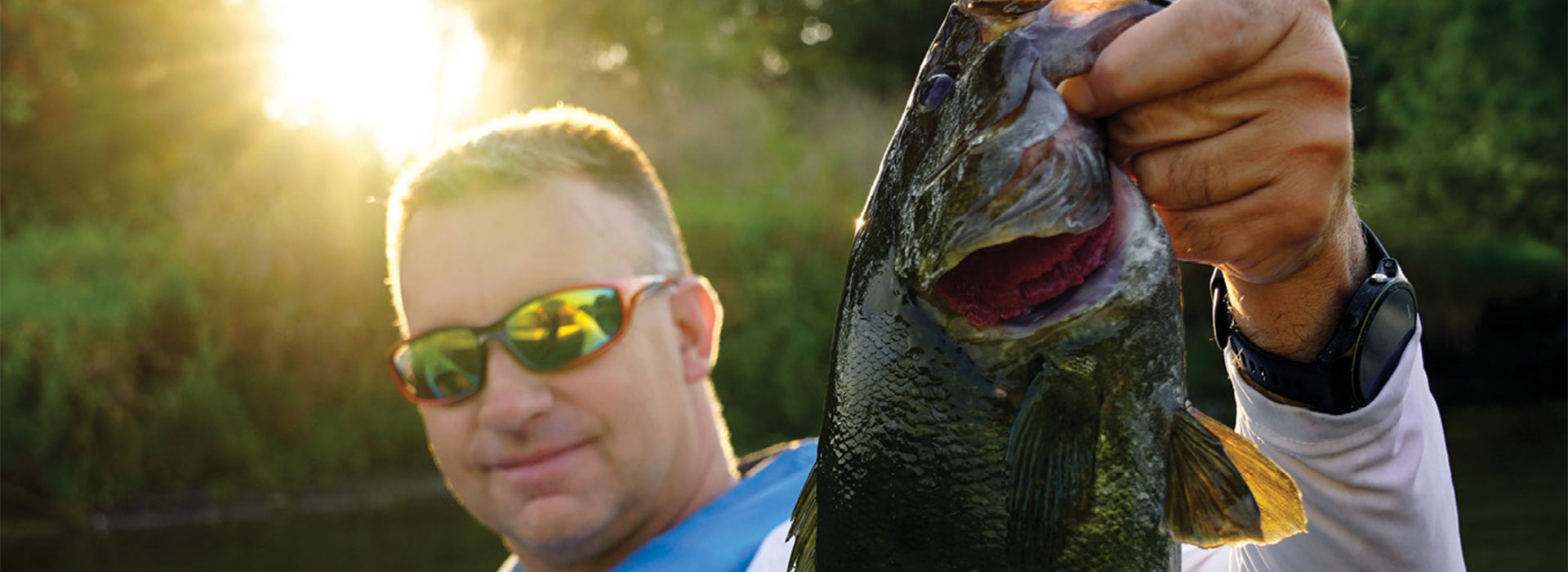Ralph Osuch drives the few blocks from his house with a 12-foot blue kayak tossed in the back of his Chevy Silverado. It’s a beautiful September morning, about 68 degrees with a steady wind blowing from the southwest. He steps over a jumble of rocks and lowers himself into his kayak on the muddy shoreline of the DuPage River in northern Illinois.
Osuch paddles to a little hole at a bend in the river that draws smallmouth bass. The morning sunlight glances off the riffling waters. Black-necked Canada geese honk overhead, and a raft of mallards explode straight up with a shower of water.
On the first cast, Osuch hooks a largemouth bass. It’s less than a pound, and he tosses it back. He casts again and hooks a 2-pound smallmouth bass that warrants a selfie before he returns it to the water. He pushes his reflective sunglasses up onto his forehead and wipes his wistful green eyes. Six months ago, he would have had his fishing buddy, Ralph Osuch Sr., with him. But his father, 79, died in March after he fell and fractured his skull.
“I’m thinking about my dad,” Osuch says. “I miss him. He’s the reason I’m out here.”
Such reflective moments on the DuPage may be in peril. A group of property owners along the river wants to restrict public access, which would prevent people such as Osuch from enjoying its serene beauty. Similar moves to restrict river access are happening elsewhere. As interest in outdoor recreation has surged, more people are clashing with property owners over the right to be on the waterways. The conflict over the uses of—and even the definitions of—public and private space is a legal conundrum bedeviling locales across the country.

“Water law is just a mess,” says attorney Zachary Pollack, who represents a group of kayakers in a water rights dispute along the nearby Mazon River in Illinois. “A lot of it’s old, and it was made when recreation wasn’t really a thing. You’ve now got a system of regulating all the waters in Illinois, and it’s terribly antiquated.”
Those antiquated laws are being challenged because of the increased demand to paddle the nation’s waterways. “If there is one thing we’ve learned in the past year, it’s how much Americans value the outdoors,” says Mark Singleton, executive director of American Whitewater. “You walk into a store to try to buy a boat, and there aren’t any.”
In 2020, sales of paddle sports products increased 56% over the prior year as millions of holed-up consumers started buying and renting kayaks, stand-up paddle boards and all manner of brightly colored inner tubes. And some of the estimated 38 million paddlers nationwide are hitting rivers and streams that carry them through private property.
The conflict along the DuPage River began in the town of Plainfield during the pandemic summer of 2020 when Kris Most, a local banker and acquaintance of Osuch, quit her job and started Plainfield River Tubing with her husband, Scott. It wasn’t long before riverside homeowners, led by William Sima, complained about the waves of tubers floating by.
“COVID happened,” says Brian Walaszek, a fellow angler and friend of Osuch. “People were stuck in their houses. All the sudden, you went from 100 people a day on the river to 500. I get their complaint with the traffic.”
Sima and another property owner alleged tubers were drunk, loud, tossing trash and even urinating on their property. In what he called an ultimatum designed to get attention, Sima asked officials to shut down the DuPage River to the public. “We don’t want people stopping and partying ... getting out of the tubes, walking on our [riverbed] property,” the young engineer says. “It sucks because it is hindering our enjoyment of the river.”

Property owners say they are also worried about liability and crime—but mostly, they just want to be left alone. Some are taking matters into their own hands.
And on the Mazon River, one of the most scenic in the region, kayakers have been threatened, chased by cars along the route and had the sheriff called on them for trespassing, prompting the lawsuit over access rights.
The DuPage River, a 63-mile nature corridor through the western Chicago suburbs, where over 1 million people make their home, provides an irresistible green escape from the concrete and sprawl. On its southern end, it slices through Plainfield, a rapidly growing exurb of 45,000 people about 40 miles southwest of Chicago.
Troubled by the threat of closing his favorite river to the public and by personal attacks on Most’s business, Osuch started a Facebook group called Friends of the DuPage River. This led to a slew of impassioned posts and amateur legal opinions. Kayakers and tubers claimed the river is public. Riverside property owners said river guides were profiting at their expense.

"We don't want people stopping and partying ... getting out of the tubes, walking on our [riverbed] property." —William Sima
To generate public support for river access, Osuch also started an online petition at change.org. “When I started the petition, never in my wildest dreams did I think it would get to 500,” he says. “As soon as it hit 7,500, I started getting calls from the media.” At press time, there were more than 11,000 signatures.
The campaign generated media coverage and resolutions supporting public access from two park district boards and a forest preserve board, and five state legislators signed a letter in favor. But the groundswell bumped up against the reality of water laws.
“As a private waterway, members of the public do not have a right to utilize the river for recreation,” an Illinois Department of Natural Resources spokeswoman told Naperville Community TV in July. The department told the station that residents could petition to make a river public by proving that it is “navigable.” The department declined to comment further to the ABA Journal, but said it was monitoring the Mazon case.

An attorney for Most said the navigability of the DuPage River was obvious. Patrick J. Cullinan, of Cassiday Schade in Chicago, pointed out that the DuPage River Water Trail—consisting of maps, signage and public launches—has been funded and supported by the state for years. In a letter, he cited caselaw to show the DuPage River was “navigable in fact” since the time of the fur traders through early 20th-century paddleboats and today’s tubers. Such activity earned the public an easement for access, both by its commercial nature and by having exceeded a 20-year prescriptive period of public use that should open up the river, Cullinan argued.
Private property rights are well established and understood in the United States. There is private property and public property. A person can stand on one but not the other without permission. But water is something that land is not. It doesn’t stay in one place. Water is elusive, and that is part of its allure. Flowing water beckons, promising to take the traveler somewhere else, around the bend. A river taps into something deeply felt. In the modern world, that allure has a price, so water-adjacent property is coveted and often well-defended by its owners.
The special status of water bodies has ancient roots. The Institutes of Justinian, promulgated as a legal textbook in the sixth century by the Byzantine Roman emperor, states, “Thus, the following things are by natural law common to all—the air, running water, the sea.”
The public nature of waterways has been recognized around the world in many societies, including those of Indigenous Americans, most of whom did not believe in owning land or water. The concepts of public ownership, however, began to narrow with the colonization of North America by the British. In the Colorado Law Scholarly Commons, Charles F. Wilkinson wrote:
The English, whose common law is the most direct source of our public trust doctrine, saw ownership differently than did American Indian people and generally favored private ownership of natural resources. But the British made an exception for navigable waterways.
The common law allowed the crown to transfer some property to individuals, but other types would be held for the public, including coastlines and rivers affected by the tides, Wilkinson wrote.
"I am just a citizen, one of many thousands that want to keep the river open." —Ralph Osuch
In the New World, most rivers were not tidal. But they were no less essential for subsistence, travel, trade, farming, logging and other commercial activities that would shape the countries’ nascent common law. When the United States was formed, the 13 colonies retained title to all of the public property within their borders, including waterways and the beds beneath them. When new states were admitted, they received specific land grants from the United States. By implication, this included the ownership of all water bottoms of navigable lakes and rivers. The U.S. Supreme Court’s 1870 opinion in The Daniel Ball stated that rivers were navigable when they were “highways for commerce.”
The reservation of navigable water bodies for the public was reinforced in 1892, when the Supreme Court in the landmark case Illinois Central Railroad v. Illinois ruled that the state broke the public trust when it sold off 1,000 acres of harbor, some underwater, along Lake Michigan.
But access to waterways for the citizenry began to diverge among the states as they exercised their peculiar discretion over both the civil and common law. That process continues to this day, with states having wide latitude to arbitrate the never-ending struggle between public and private uses of the country’s natural resources.
“There is an incredible amount of variability from state to state,” said Brett Mayer, public policy chief of the American Canoe Association. “In Alabama, I can float over the water, yes, but not stand in it. It gets really tricky to understand all these things.”
For its part, the American Whitewater website lists river access laws in all 50 states and works to further pry them open.
State laws rarely align, even when the states are adjacent and a single river flows from one into the other. In Illinois’ northern neighbor, Wisconsin, there is the equivalent of a public easement on “all streams, sloughs, bayous and marsh” allowing the flotation of any recreational craft. But in Illinois, only 48 of the nearly 500 rivers and streams running 87,000 miles are designated “public.” That means people can paddle down the Des Plaines River in southern Wisconsin until they reach the Illinois border, where they would have to get out to avoid trespassing on private parcels downriver.

Why are the same rivers in the same country but in different states treated differently? One reason is that as the United States evolved in the 19th century into a society driven by economic activity, river rights were shaped by the dominant economic uses. In the Midwest, forested states like Wisconsin and Michigan used rivers to float logs to market. In prairie states like Illinois, rivers were used to irrigate and to move crops.
Over time, as the state courts adjudicated disputes, three pillars were established under common law: riparian rights, navigability and riverbed ownership. A person who owns property on a body of water has riparian rights. This includes the right to use water and to access water, known as a usufructuary right.
Navigability means the ability to ply the waters on a floating object; courts have consistently found that this refers to commercial vessels traveling on “highways for commerce.” Bed ownership means owning the land under the water. In almost all states, property owners on small and medium-size “non-navigable” rivers (the ones paddlers most want to go on), were given the right to own the bed underlying the river, halfway to the center.
A completely different type of right was established in Western states, which were admitted later. There, “prior appropriation” replaces riparian rights. Water rights are unconnected to land ownership and can be sold or mortgaged like other property.
Trying to balance separate types of water rights and then define and redefine navigability over a 250-year period in a country that went from birchbark canoes to barges—and is now at stand-up paddle boards—is a complex and challenging dilemma.

In New Mexico, where the constitution says rivers “belong to the public,” landowners in 2017 supported a controversial rule change to allow fencing in streams popular with trout fishermen and boaters. The Adobe Whitewater Club and other conservation groups petitioned the New Mexico Supreme Court in 2020 to uphold public access. In August, the state Game Commission rejected several landowner applications for private river status. The battle continues.
In southwest Virginia, kayakers were issued summonses for trespassing on a prime whitewater run on Johns Creek. The landowners claimed creek ownership via a king’s grant, a reference to land given to colonists by King George II in the 18th century, predating the Virginia commonwealth. The state in 2015 declared the creek navigable, allowing kayakers to run it. The landowners filed suit against the state, seeking to overturn that decision. The suit was dropped after one of them died.
In Wisconsin, where logs were sent down rivers for commercial transport, navigability extends to kayaks and canoes. In Illinois, the Prairie State, the combination of private bed ownership, the commercial non-navigability of most rivers and common law riparian rights means that water is terra firma in law, and therefore really no different from private property on land. And that’s the way some property owners want it.
On the Mazon River, there’s more at stake than serene paddling through scenic shale formations and riffling rock gardens. Along the deep-cut riverbanks are unique 300 million-year-old Carboniferous period fossils that have become much-coveted.
Fossil hunters have hammered out hundreds of never-before-discovered species from concretions, small oval rock formations, some containing fossil imprints of ancient ferns or horseshoe crabs. The bizarre-looking “Tully Monster”—the Illinois state fossil featured on the side of some U-Haul trucks—was discovered in the area, which is now designated a U.S. National Historic Landmark. Today, Mazon Creek fossils are displayed in a dedicated section of Chicago’s Field Museum of Natural History, and they are being sold on the internet for anything from a few bucks to over $1,000.
The Holm family owns property along the Mazon and uses it to launch their kayaks downstream to another riverside property to collect fossils, which they sell to the public. Another owner of riverfront farmland, Peter Kodat—who allows some science club members to search on his property—called the sheriff on a Holm father and son, alleging they were trespassing by crossing over their riverbed and stealing fossils. After an arrest for trespassing (the charges were later dismissed) and numerous conflicts—including an order of protection issued against one family member—the Holm family filed suit, seeking to establish their riparian rights to traverse the river freely.
"You're talking about limiting access based on the whims of a few property owners and restricting access to thousands of miles of streams, rivers and creeks." –Zachary Pollack, attorney for the Holm family
The trial judge in Grundy County first granted summary judgment in favor of the Holm family. Both parties were represented by small local firms, and the judge accepted the argument that a river was like a lake, and all lakefront property owners could use the entire lake, as decided in Beacham v. Lake Zurich Property Owners Association (1988). Therefore, all riverfront owners should be allowed to traverse the entire river, Holm argued.
The losing defendants hired attorneys from two downtown Chicago firms and filed a motion for summary judgment on reconsideration. Chad Layton, a lawyer at Segal McCambridge Singer & Mahoney, says he prepared a new brief that included caselaw going back 120 years to demonstrate that a river is not the same as a lake for property owners, and that the riparian rights on a river did not allow passing over and through a private riverbed. Looking at the newly presented cases, the judge agreed, Layton says.
In response, the Holm family appealed and lost in 2021. The unanimous opinion stated that “each defendant may lawfully bar any and all trespassers from the segment of the Mazon River that abuts his respective parcel of property. ... Both plaintiffs and defendants have private property rights, attributable to their status as riparian owners, that are superior to the interests of the general public ... [and] all other riparian owners. Therefore, the riparian owner of each individual parcel of private property, situated along the Mazon River, may lawfully bar access, within their easily ascertainable property lines, to any person.”
The kayaking and fossil-hunting Holm family in the Mazon Creek case have now appealed to the Illinois Supreme Court, which agreed to review the case.
“It certainly has huge ramifications,” Holm attorney Zachary Pollack says. “You’re talking about limiting access based on the whims of a few property owners and restricting access to thousands of miles of streams, rivers and creeks.” Understanding this, the Will County Forest Preserve filed an amicus brief in the Mazon case to preserve public access to the DuPage.
A decision for either party is unlikely to dampen interest in river running in Illinois. In small numbers, river users often float under the radar—sometimes with tacit landowner approval. But larger numbers have stoked conflict, and the law hasn’t caught up to the new reality of rivers that are highways for a new kind of commerce. It’s no longer a company damming a stream to power a grain mill or French trappers like the river’s namesake, DuPazhe, trading furs for cutlery with Potawatomi. Today, it’s a 14-year-old girl floating in a bright pink tube accompanied by a dog in a shark fin life jacket.
Easy solutions to the recurring cycle of conflict and a balancing of the public and private are elusive. A state declaration of riverbeds and waterways as public would likely violate constitutional due process and qualify as an unlawful taking of property without just compensation. It is similarly difficult to imagine taxing bodies spending millions of dollars to buy up miles of riverbed and access points. So river enthusiasts are left, in part, with the words of the justices in the Mazon case who urged parties to “maintain good relationships with their neighbors. Those relationships could determine whether, by permission or contract, a right of access is granted.”

Retired teacher and former small-business owner Pat Lawlor took the neighborly approach when she formed a group in northern Illinois called Paddle the Kish in Marengo. Her goal is to make a remote eastern branch of the Kishwaukee River into a well-marked water trail with public access points. In addition to selling T-shirts and organizing teams of members to clear logjams, add signage and build trails, she is also knocking on property owners’ doors for permission to paddle through. She’s halfway there. “We have to solve this private land thing,” Lawlor says. “We’ve been really successful with that, neighbor to neighbor. I’ve not had a hard time with property owners.”
Cooperation along the DuPage has been scarce, and emotions hot. Plainfield fisherman Osuch says he’s just trying to live up to what his dad would have wanted.
“I am just a citizen,” Osuch says, “one of many thousands that want to keep the river open. I can’t help thinking my dad had something to do with me getting involved.”
Zack Nauth is a journalist and former reporter for the New Orleans Times-Picyaune. He lives in Oak Park, Illinois, and spends a lot of time outdoors.